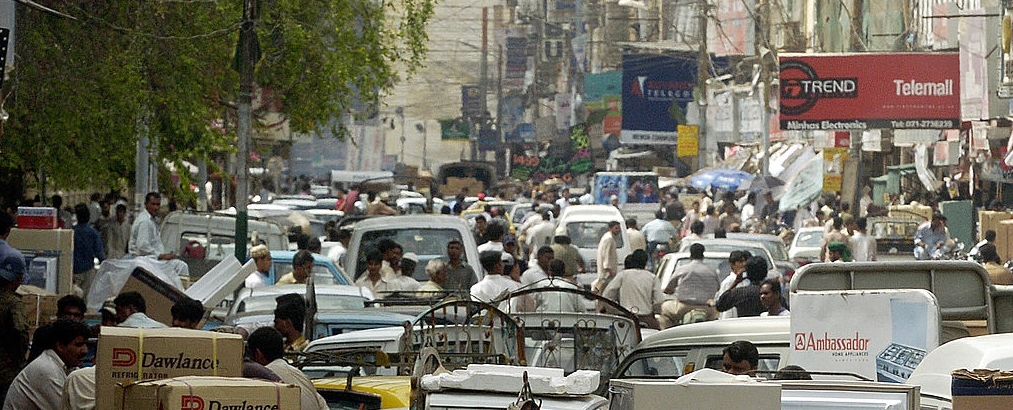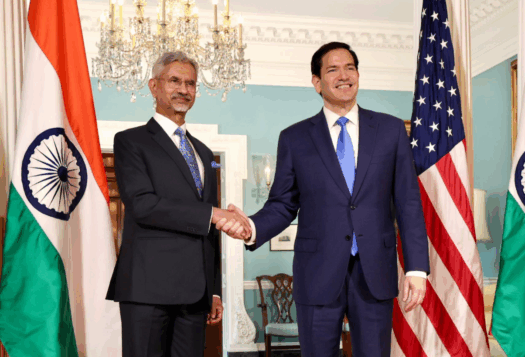
Asia’s urbanization is one of its defining features today. During the first decade of the twenty-first century, almost 200 million people moved to cities in Asia. As of 2010, the Asia-Pacific region was the second least urbanized region in the world but had the second fastest urban population growth rate at 2% a year. Among all the sub-regions in the Asia-Pacific, South and Southwest Asia had the fastest urban population growth rates from 2005-2010 (at 2.4% per year). According to data available in 2005, over 30% of the Indian urban-dwelling population lived in slums, while in Pakistan the figure was over 40%. The number of people living in slums in India reached 65 million in 2013.
South Asia was relatively late to urbanization, but has begun to catch up during the last two decades as its urban population has swiftly grown. Across South Asia, less than 40% of the population lives in cities. However, some Indian states as Tamil Nadu, Maharashtra, and Gujarat have urbanization rates of over 50%. Over 50 cities have populations greater than a million people. Other cities in the region have become urban centers with more than ten million people, including Dhaka, Kathmandu, Colombo, and Karachi. Over the next few decades, South Asia is expected to experience a massive rise in urban population. Between 2014 and 2050, India’s urban population will increase by an additional 404 million people.
A common feature plaguing growth in South Asian urban centers is unplanned urbanization. Undeliberated and unplanned urban development gives birth to various economic, social, and political problems. When large numbers of people move to urban centers without any prearranged roadmap, the existing infrastructure often proves to be insufficient to support more people. As a result, the city’s economy gets disturbed, resulting in conditions that can breed threats to national security.
Urbanization in democratic states is considered to be synonymous with development and improved living conditions through increased services and opportunities for citizens. However, when people are excluded from developed urban centers and instead inhabit the underdeveloped peripheries, they are denied the economic and social benefits of urban living, which can cause violence and insecurity to ensue. In developing countries, urbanization tends to take the form of uncontrollable sprawling and fragmentation. This fragmentation prevents social integration and cohesion, which ferments social disparity. As a result, crime becomes a common characteristic of urban centers. Complicating the problem, there is no uniform pattern of migrations to cities. People from distinct ethnic and cultural backgrounds move to cities, and if not managed properly, these differences can provoke conflict.
In South Asian urbanization patterns, these issues are common and overwhelming. Criminality and violence in cities emerge not only due to financial disparity, but also due to social reasons. When the social fabric of a city society is not cohesive, emotional disturbances among the population may result, which can transform into violence. Compared to the urban centers, the populations living in the peripheries of the cities suffer from infrastructural, economic, and social problems. These discrepancies increase because cities have weak institutional systems to control outer populations. People living in the margins of cities often lack basic necessities, which adds to already existing problems. Problems with public transport systems and environmental pollution also makes things worse. These challenges lead to the isolation of periphery citizens, motivating them to turn to criminal activities.
In South Asia, India is the second largest country in world by means of population. According to the 2011 census, Mumbai’s population is 18.4 million, which makes it the largest city in India and the fifth largest city in world. Delhi is the second largest city in India with a population of over 16 million; a large proportion live in slums. Eight other cities – Bangalore, Hyderabad, Ahmedabad, Chennai, Kolkata, Surat, Pune, and Jaipur – have a population over three million. Pakistan has eight cities with a population over one million. Karachi is the largest of these cities with a population of 11.6 million. Lahore follows with six million residents.
South Asian economies are transforming rapidly into manufacturing and service industries. This leads to more migration to cities as they become job hubs. Although increased urbanization improves GDP, it can exert other economic pressures, especially in developing economies. Governance will be the key issue in overcoming urbanization challenges in South Asia. Governance of urban centers is more difficult and challenging due to challenges resulting from spatial management.
Civil conflicts occur due to a state’s failure to provide security, welfare, and growth, which paves the way for militant and extremist campaigns and violence. These acts of violence are not necessarily aimed at taking control of the state, but can be opportunistic attempts at exploiting insecure urban environments to achieve their goals. There is wider opportunity to be invisible. South Asia is a conflict ridden and terrorism afflicted region. The violence in urban centers may take the form of terrorism. Political, social, economic, and security fissures stemming from urbanization provide regional terrorists with ample opportunity to sneak into main city centers and cause huge losses to states.
South Asian nations share many problems. The urbanization trends of the region will bring about a string of economic and security issues, which will offer many opportunities to work together. When states share so much in common – both challenges and opportunities – they can combine efforts. Urbanization and urban security are alarming issues for South Asia currently and will continue to be in the near future. This challenge requires a quick and consolidated effort.
***
Image: Asif Hassan-AFP, Getty


